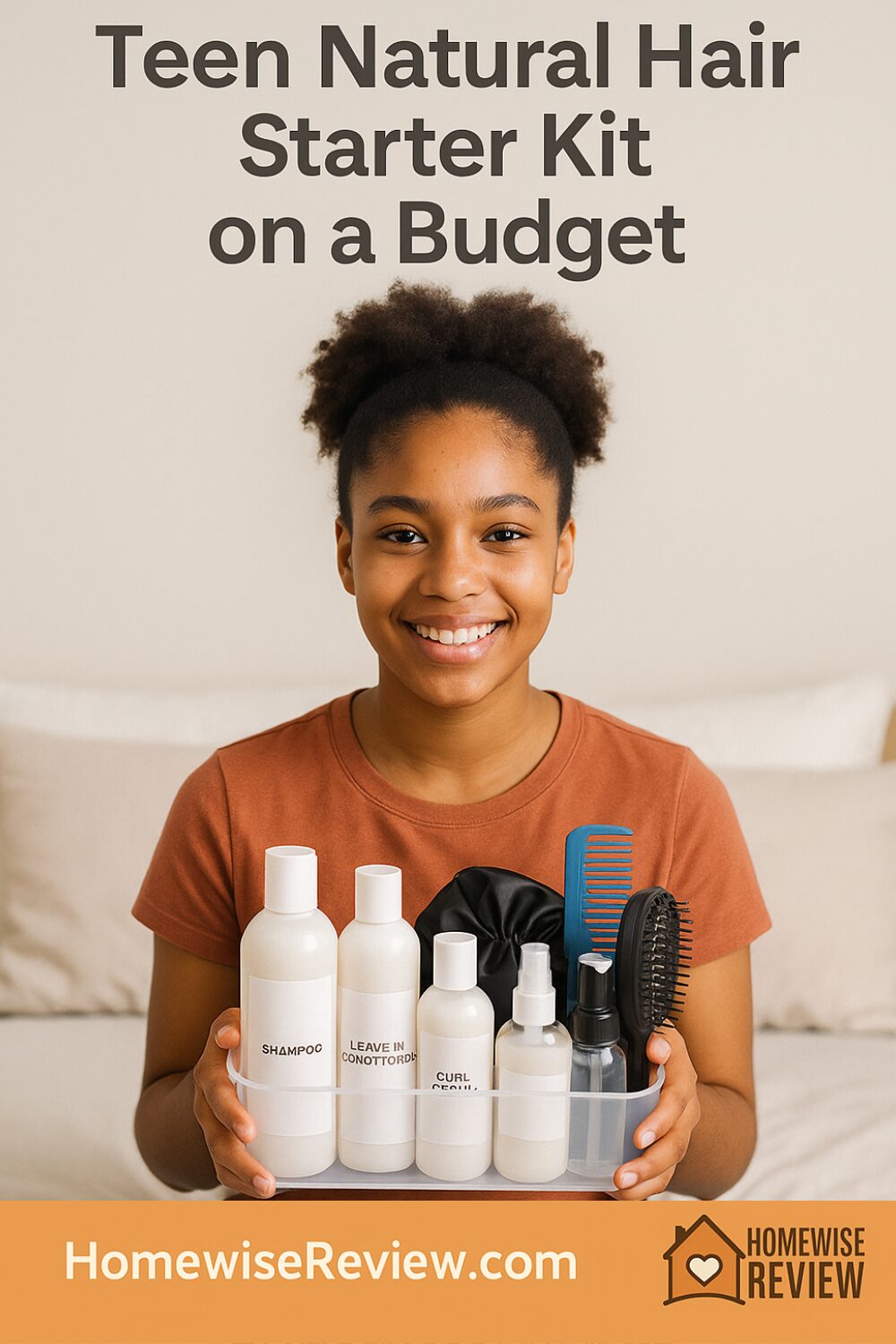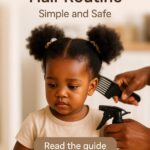
Who this is for: Parents and teens building a simple, affordable routine for natural African-textured hair.
Bottom line: Keep it light, keep it repeatable, and spend where slip and hold matter. A budget kit needs five things that work together: gentle cleanse, high-slip conditioner, leave-in, styler, and night protection. Add a detangling tool and oil only if you need it.
Quick comparison: the 8-piece budget kit
| Item | Why it matters | Teen-friendly pick type | How to use |
|---|---|---|---|
| Moisturizing shampoo | Cleans scalp without stripping | Drugstore sulfate-free curl shampoo | Once weekly. Massage scalp, let suds run through ends. |
| High-slip conditioner | Pain-free detangling, fewer tears | Rinse-out with fatty alcohols + silicones or polyquats | Work in sections, detangle from ends up, then rinse. |
| Leave-in conditioner | Daily moisture without grease | Lightweight cream or milk | Nickel size on damp hair after wash or morning spritz. |
| Curl cream or gel | Definition and frizz control | Cream for twist outs, gel for wash and go | Use one, not both. Smooth through sections, then style. |
| Light oil/serum (optional) | Seals ends and adds shine | Sunflower, grapeseed, or silicone serum | One to two drops on ends only. |
| Detangling tool | Faster, gentler detangling | Wide-tooth comb or flexible detangling brush | Always on wet hair with slip. |
| Satin bonnet or pillowcase | Preserves moisture and style | Youth size bonnet or zip pillowcase | Wear nightly so styles last. |
| Spray bottle | Easy refresh | Fine mist bottle | Warm water + a splash of conditioner for morning reset. |
If you purchase through links on our site, we may earn a small commission at no extra cost to you.
Budget tiers you can shop today
Under 40 dollars: bare essentials
- Moisturizing shampoo
- High-slip conditioner
- Leave-in
- Satin bonnet or pillowcase
This set handles wash day, daily moisture, and sleep protection. Style with chunky twists, puffs, or braids using leave-in alone.
Under 75 dollars: balanced starter
- Everything above, plus curl cream or gel
- Wide-tooth comb or flexible detangling brush
- Fine mist spray bottle
Now you get definition that lasts through the school day and faster detangling without tugging.
Under 100 dollars: complete but still simple
- Everything above, plus a light oil or silicone serum
- Extra bonnet for backups
- Beadless satin scrunchies
You can seal ends in dry months, preserve styles longer, and avoid breakage from tight elastics.
How to set the routine
Weekly wash day (about 45 to 60 minutes)
- Pre-detangle lightly with water and a touch of conditioner if hair is very tangled.
- Shampoo the scalp in 4 to 8 sections. Pads of fingers only.
- Condition with slip. Add a little water to help the conditioner spread, then detangle from ends up.
- Rinse to plush. Hair should feel soft, not squeaky.
- Leave-in, then styler. Use a nickel of leave-in per section. Pick cream for twist outs and braids. Pick gel for wash and go.
- Air dry or use cool only. Fully dry before separating to avoid frizz.
Daily refresh (5 minutes)
- Spritz with warm water.
- Smooth a pea of leave-in through ends.
- Seal ends with one drop of oil if hair feels crispy.
- Protect at night with the bonnet or satin pillowcase.
Deep dives on the core pieces
1) Moisturizing shampoo
Why it works
Teens need a clean scalp for comfort and growth retention. A gentle formula removes sweat, gel, and school-day dust without roughing up the cuticle.
How to use
Once weekly is plenty. Focus on the scalp. Let suds slide through the lengths so you do not over-clean the ends.
Keep in mind
Swimmers or athletes can do a midweek quick wash focused on the hairline and nape.
Who it’s for
All curl patterns, especially when gel is part of the routine.
2) High-slip conditioner
Why it works
Slip turns detangling from a fight into a glide, which means less breakage and fewer tears. Look for conditioners that feel creamy and spread easily with water.
How to use
Apply in sections. Add a handful of water to the hair to activate slip, then detangle from the last inch upward.
Keep in mind
If hair mats easily, leave a pea of conditioner in the ends rather than rinsing bone clean.
Who it’s for
Thick coils and curls, types 3 to 4C.
3) Leave-in conditioner
Why it works
Daily moisture without weight is the difference between soft spirals and crunchy frizz by lunch. Leave-ins set up both cream and gel days.
How to use
After every wash, apply on damp hair from mid-lengths down. For morning refresh, use a pea and scrunch.
Keep in mind
If the scalp looks greasy by day two, you are using too much. Keep product away from the roots.
Who it’s for
Everyone, year round.
4) Curl cream or gel
Why it works
You need hold that matches the look you want. Creams give soft definition and are great for twists and braids. Gels give more hold for wash and go or sleek puffs.
How to use
Pick one. On damp hair, rake through small sections, then smooth with praying-hands. For gel, avoid touching until fully dry.
Keep in mind
Flakes come from over-layering. If you see dusting, use less leave-in or switch to a compatible pair from the same brand family.
Who it’s for
Cream lovers who want touchable hair and gel lovers who want cast that lasts through gym.
5) Light oil or silicone serum
Why it works
A tiny seal on the ends slows moisture loss and adds shine without greasing the scalp.
How to use
One to two drops on the last inch only. On takedown days, coat palms before unraveling twists to reduce frizz.
Keep in mind
Skip heavy butters for daily use. Save them for winter or protective styles.
Who it’s for
High-porosity ends, dry climates, or teens who love extra shine.
6) Detangling tool
Why it works
A wide-tooth comb or flexible brush lets you chase knots with less force than a small comb.
How to use
Always on wet hair with conditioner or leave-in. Ends first, then inch upward.
Keep in mind
If the brush snags, go smaller sections and add water. Finger detangling first helps a lot.
Who it’s for
All patterns, especially dense 4A–4C.
7) Satin bonnet or pillowcase
Why it works
Satin reduces friction that causes frizz and snapped edges. Styles last longer, which saves time before school.
How to use
Wear nightly. If bonnets slide off, add a satin pillowcase as backup.
Keep in mind
Replace stretched bands so the fit stays gentle but secure.
Who it’s for
Everyone.
- Twist set, 8 to 12 twists: Cream only, dry fully, then unravel for soft definition that lasts 3 to 4 days.
- Wash and go: Leave-in plus gel, hands off until dry, then scrunch out the cast.
- Two puffs or low bun: Gel the hairline lightly, brush gently, tie a satin scarf for five minutes to set.
- Chunky braids for the week: Cream, large parts, loose bases to protect edges.
Troubleshooting
- Flaking or white cast: Too much product or a clash between leave-in and gel. Use less or pair from the same line.
- Frizz by noon: Hair was not fully dry. Dry completely before separating, and sleep with satin.
- Tight, shiny scalp: Bases are too tight. Redo now. Teens need low tension at the hairline.
- Dry ends that tangle: Dust a tiny trim, then seal ends with a drop of oil for two weeks.
- Greasy roots, dry lengths: Keep stylers below mid-lengths and switch to a lighter leave-in.
Final Thoughts
A teen-friendly kit does not need 12 products. Spend on slip, pick one styler, protect at night, and keep wash day weekly. The right habits make morning hair easy and protect edges for the long haul. Build the kit once, then let the routine carry the load.
See Also
If you want the exact categories and affordable picks laid out by step, start with Natural Hair Products | Best Picks for Coils, Curls, Kinks so your shampoo, conditioner, leave-in, cream, and gel all play nicely together. When you are learning curl patterns and what styles tend to last for school days, the visuals in Curl Pattern Map and Care Basics: 2A to 4C with Routine Starters help set expectations and guide your choice between a cream week and a gel week.
For faster, tear-free wash days, borrow the sectioning and detangling flow in Wash Day Routine for 4C Hair Step by Step, then choose a gentle tool from Best Brushes for 4C Hair Detangling and Stretching so you are not fighting knots. If you want stretch without a blow-dryer for easier styling, the side-by-side in Stretching Without Heat Methods Compared: banding, African threading, roller sets shows how to pick the method that matches your time and finish.
FAQs
How many products does a teen really need
Five core items cover it. Shampoo, conditioner, leave-in, one styler, and satin protection. Add a detangling brush and a light oil if needed.
Cream or gel for school days
Cream for soft twist outs or braids. Gel for wash and go or sleek puffs that need hold through PE.
How often should teens wash natural hair
Weekly is a good start. Very active teens who sweat a lot can add a midweek quick cleanse focused on the scalp.
Do teens need protein treatments
Only if hair feels overly soft and won’t hold a set. Start with a light protein conditioner once or twice a month.
What is the safest way to use elastics
Use satin or fabric-covered ties, never tight double wraps at the hairline, and change the direction of puffs or buns so one spot is not under constant pull.
Affiliate Disclosure
If you purchase through links on our site, we may earn a small commission at no extra cost to you.




